Related Research Articles
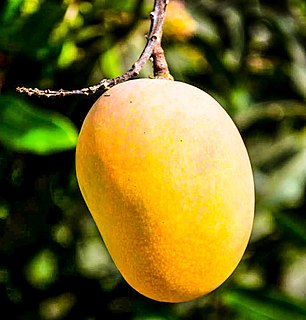
A mango is an edible stone fruit produced by the tropical tree Mangifera indica which is believed to have originated from the region between northwestern Myanmar, Bangladesh, and northeastern India. M. indica has been cultivated in South and Southeast Asia since ancient times resulting in two distinct types of modern mango cultivars: the "Indian type" and the "Southeast Asian type". Other species in the genus Mangifera also produce edible fruits that are also called "mangoes", the majority of which are found in the Malesian ecoregion.

Arizona Beverages USA is an American producer of many flavors of iced tea, juice cocktails, and energy drinks based in Woodbury, New York. Arizona's first product was made available in 1992.

'Chaunsa', also known as 'chausa', is a named mango cultivar from South Asia. It is grown mainly in Pakistan and some parts of India; both countries export significant quantities of the fruit.
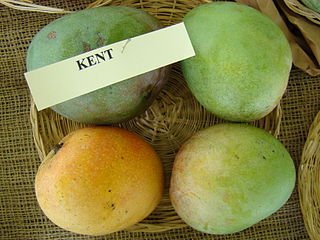
The 'Kent' mango is a named mango cultivar that originated in south Florida.

Banganapalle mangoes is a mango variety produced in Banganapalle of Kurnool district in the Indian state of Andhra Pradesh. It alone occupies 70% percent of total mango cultivable area of the state and was first introduced by the Farmers of Banaganapalli. It was registered as one of the geographical indication from Andhra Pradesh on 3 May 2017, under horticultural products by Geographical Indication Registry. It is also grown in the other parts of India and Pakistan. The fruit is described as obliquely oval in shape, around 14 cm in length, with yellow flesh and a thin, smooth yellow skin. The flesh is of a firm, meaty texture and is sweet and lacks fibre. The cultivar is the most sought after in Andhra Pradesh. It is a mid-season variety that is good for canning. This cultivar is a source of vitamin A & C and is also called king of Mangoes.

The 'Edward' mango is a named mango cultivar that originated in south Florida.

The 'Ataúlfo' mango, also called young, baby, yellow, honey, Adaulfo, Adolfo,or Champagne, is a mango cultivar from Mexico. Ataulfo mangos are golden yellow and generally weigh between 6 and 10 ounces, with a somewhat sigmoid (oblong) shape and a gold-blushed yellow skin. Their buttery flesh is not fibrous, and they have a thin pit. Their flesh is a deep yellow and high in sugar, with a rich, sweet flavor. They were named for grower Ataulfo Morales Gordillo. Since August 27, 2003, the Ataulfo mango is one of the 18 Mexican Designations of Origin.
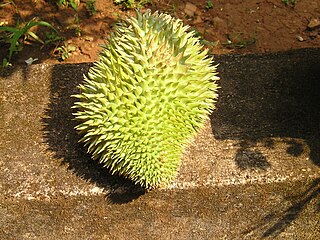
The District Agricultural Farm, Taliparamba is one of the oldest farms in India. It is located at Karimbam village on Taliparamba to Irikkur road in Kannur district of Kerala province in India.
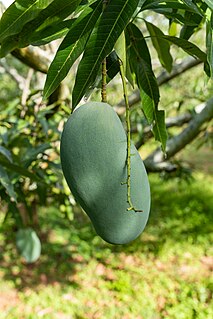
The 'Mallika' mango is the result of the hybridization of the Indian mango varieties Neelum and Dasheri. The variety was introduced by Dr. Ramnath Singh. When grafted, the tree will remain a manageable size and is appropriate for dooryard growing. Fruit is normally ready to harvest from June to July.

The 'Cushman' mango is a mango cultivar that originated in south Florida. The variety had limited to no commercial application but has been sold as a dooryard tree.
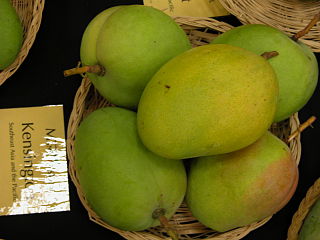
The 'Kensington Pride' mango is a named commercial mango cultivar that originated in Australia. It is sometimes called the KP, Bowen or Bowen special. It is Australia's most popular mango, accounting for over 80% of the country's annual commercial mango market. It is considered to have a distinctive flavour and aroma when compared with the Florida-bred cultivars grown by most mango-exporting countries.

The 'Parvin' mango is a named commercial mango cultivar that originated in Southwest Florida.

Malgova' or Malgoa is an important mango cultivar mainly grown in Tamilnadu and Karnataka and also in other parts of South India. It is a large round fruit, it has a small hard seed inside and is very juicy and fragrant. It is generally considered to be one of the best mangoes. Its production area is centred on the districts of Salem, Dharmapuri and Krishnagiri in Tamil Nadu, Gujarat, as well as neighbouring parts of Andhra Pradesh and Karnataka.
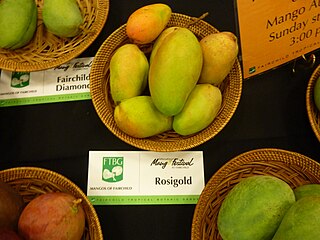
The 'Rosigold' mango is a named, early-season mango cultivar that was selected in south Florida.
The 'Torbert' mango is a named mango cultivar that originated in south Florida. It is sometimes incorrectly spelled Torbet or Tolbert.

The 'Nam Dok Mai' mango is a mango cultivar which originated in Thailand. It is the most popular mango variety in Thailand, and is grown commercially in Australia as well, albeit as a minor variety.

Honeynut squash is a winter squash cultivar bred from butternut and buttercup squash. It has a similar shape and flavor to butternut squash but averages about half the size and is significantly sweeter. It has dark tan to orange skin and orange fleshy pulp. When ripe, it turns from green to a deep orange and becomes sweeter and richer. It has two to three times more beta-carotene than butternut squash. Although technically a fruit, honeynut squash is used as a vegetable that can be roasted, sautéed, puréed, added to soups, stews, and braises, and is suitably sweet for desserts.
Anwar Ratol is a small, yellow variety of mango known for its sweetness and fiberlessness. It is sometimes called the 'mini powerhouse'. It is cultivated in the Punjab and Sindh regions of Pakistan, and near the village of Rataul in Uttar Pradesh, India. It is very sweet in taste with less fiber.
References
- ↑ "Australian Varieties". Australian Mangoes. Retrieved 24 January 2017.
- 1 2 3 "About Honey Gold Mangoes". Pinata Farms. Retrieved 24 January 2017.
- ↑ "Honey Gold mangoes fetch top dollar in markets across Australia". 15 January 2016. Retrieved 24 January 2017.
